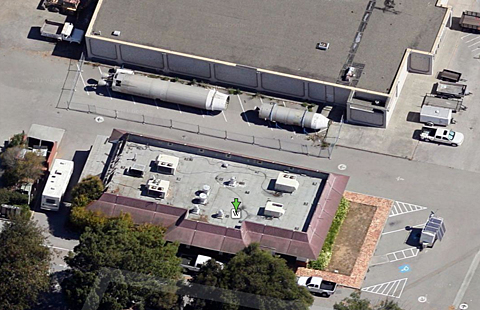 A Real Estate Deal That Spans The Earth, NPR
A Real Estate Deal That Spans The Earth, NPR
“As it turns out, the greatest interest in the property has been because of that satellite dish. NASA contractor Dennis Wingo is seriously looking at it. He’s advising a team competing for the Google Lunar X Prize, a $20 million award for the first privately funded team to get a rover to travel on the moon. “We would control them from here,” Wingo says. “To me, that’s way more fun than worrying about the past. As important as the past is, I kind of look forward toward the future.” At this point, Wingo hasn’t made an offer, so the property is still on the market. The asking price for the dish, the bunker and the land: $4.2 million.”
Lunar Orbiter Image Recovery Project Featured in MountainView Voice
 One giant leap for former fast-food joint, MountainView Voice
One giant leap for former fast-food joint, MountainView Voice
“Inside a shuttered McDonald’s at NASA Ames Research Center is a surreal scene: stacks of silver disc-shaped film canisters, an old reel-to-reel tape machine and the sound of NASA technicians talking during a 1960s mission to photograph the moon. What is going on is a sort of archeology of the digital age, or “techno-archeology” as it is called by Dennis Wingo, the man in charge of the Lunar Orbiter Image Recovery project. Wingo, CEO of Skycorp Inc., is the space industry entrepreneur who partnered with NASAWatch.com editor Keith Cowing to promote the project in 2008.”
China Releases High Resolution Moon Maps Made From Chang’e-2 Data

China on Monday published a set of full coverage of moon map and moon images with a resolution of seven meters captured by the country’s second moon orbiter, the Chang’e-2. (Xinhua Photo)
BEIJING, Feb. 6 (Xinhua) — China on Monday published a full coverage map of the moon, as well as several high-resolution images of the celestial body, captured by the country’s second moon orbiter, the Chang’e-2.
The map and images, released by the State Administration of Science, Technology and Industry for National Defence (SASTIND), are the highest-resolution photos of the entirety of the moon’s surface to be published thus far, said Liu Dongkui, deputy chief commander of China’s lunar probe project.
The images were photographed by a charge-coupled device (CCD) stereo camera on the Chang’e-2 from heights of 100 km and 15 km over the lunar surface between October 2010 and May 2011, according to a statement from SASTIND.
The resolution of the images obtained from Chang’e-2 is 17 times greater than those taken by the its predecessor, the Chang’e-1.
Continue reading “China Releases High Resolution Moon Maps Made From Chang’e-2 Data”
Where is McMoon’s?
McMoons is located here at NASA Ames Research Park at Moffett Field, CA. Next to our building (Building 596) is a 50 year old Titan 1 ICBM that we’re helping students to restore, upgrade, and transform into a teaching tool. We like to make old stuff work.
Click on images to enlarge
More images below
Technoarchaeology: Learning New Things from Old Technology
 Technologies that we’ve lost – and the quest to find them again, io9
Technologies that we’ve lost – and the quest to find them again, io9
“I asked NASA Watch’s Keith Cowing about this, and he explained that this is just an urban legend. The schematics are all still around, mostly on microfiche, and any ancient computer files just hold images of the original plans as opposed to now unreadably obsolete data. Still, while the knowledge wasn’t lost, it was certainly forgotten, and worse, it was badly organized. As Cowing – himself working on the rediscovery of old NASA documents with the Lunar Orbiter Image Recovery Project – told me, all this archival information was basically abandoned until NASA’s started working on the Constellation program last decade, and now that that project has been forgotten the information is again beginning to gather dust. If there is a point of disconnect, it’s more in terms of how we understand the information and the different ways in which we approach science forty-five years on:”
“If anything’s missing, it’s actually more the explanation. I mean there is some stuff that will never be found again, but it’s all there, and the stuff that isn’t you can sort of figure out backwards. Sometimes you need the equivalent of a Rosetta Stone, because sometimes the way we think today is not the way they thought back then. Sometimes you need an index or a document that explains how they did things or their nomenclature. That’s the one thing that’s sometimes hard to find is what I call a bridge document, an answer guide to how they did the thing back in the sixties. There’s no FAQ.”

